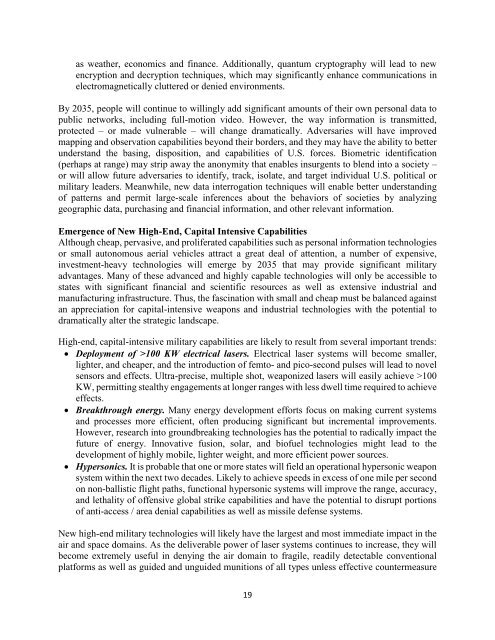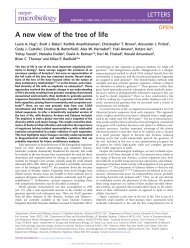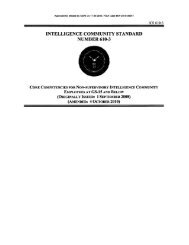The Joint Force in a Contested and Disordered World
JCS-JOE-2035
JCS-JOE-2035
You also want an ePaper? Increase the reach of your titles
YUMPU automatically turns print PDFs into web optimized ePapers that Google loves.
as weather, economics <strong>and</strong> f<strong>in</strong>ance. Additionally, quantum cryptography will lead to new<br />
encryption <strong>and</strong> decryption techniques, which may significantly enhance communications <strong>in</strong><br />
electromagnetically cluttered or denied environments.<br />
By 2035, people will cont<strong>in</strong>ue to will<strong>in</strong>gly add significant amounts of their own personal data to<br />
public networks, <strong>in</strong>clud<strong>in</strong>g full-motion video. However, the way <strong>in</strong>formation is transmitted,<br />
protected – or made vulnerable – will change dramatically. Adversaries will have improved<br />
mapp<strong>in</strong>g <strong>and</strong> observation capabilities beyond their borders, <strong>and</strong> they may have the ability to better<br />
underst<strong>and</strong> the bas<strong>in</strong>g, disposition, <strong>and</strong> capabilities of U.S. forces. Biometric identification<br />
(perhaps at range) may strip away the anonymity that enables <strong>in</strong>surgents to blend <strong>in</strong>to a society –<br />
or will allow future adversaries to identify, track, isolate, <strong>and</strong> target <strong>in</strong>dividual U.S. political or<br />
military leaders. Meanwhile, new data <strong>in</strong>terrogation techniques will enable better underst<strong>and</strong><strong>in</strong>g<br />
of patterns <strong>and</strong> permit large-scale <strong>in</strong>ferences about the behaviors of societies by analyz<strong>in</strong>g<br />
geographic data, purchas<strong>in</strong>g <strong>and</strong> f<strong>in</strong>ancial <strong>in</strong>formation, <strong>and</strong> other relevant <strong>in</strong>formation.<br />
Emergence of New High-End, Capital Intensive Capabilities<br />
Although cheap, pervasive, <strong>and</strong> proliferated capabilities such as personal <strong>in</strong>formation technologies<br />
or small autonomous aerial vehicles attract a great deal of attention, a number of expensive,<br />
<strong>in</strong>vestment-heavy technologies will emerge by 2035 that may provide significant military<br />
advantages. Many of these advanced <strong>and</strong> highly capable technologies will only be accessible to<br />
states with significant f<strong>in</strong>ancial <strong>and</strong> scientific resources as well as extensive <strong>in</strong>dustrial <strong>and</strong><br />
manufactur<strong>in</strong>g <strong>in</strong>frastructure. Thus, the fasc<strong>in</strong>ation with small <strong>and</strong> cheap must be balanced aga<strong>in</strong>st<br />
an appreciation for capital-<strong>in</strong>tensive weapons <strong>and</strong> <strong>in</strong>dustrial technologies with the potential to<br />
dramatically alter the strategic l<strong>and</strong>scape.<br />
High-end, capital-<strong>in</strong>tensive military capabilities are likely to result from several important trends:<br />
Deployment of >100 KW electrical lasers. Electrical laser systems will become smaller,<br />
lighter, <strong>and</strong> cheaper, <strong>and</strong> the <strong>in</strong>troduction of femto- <strong>and</strong> pico-second pulses will lead to novel<br />
sensors <strong>and</strong> effects. Ultra-precise, multiple shot, weaponized lasers will easily achieve >100<br />
KW, permitt<strong>in</strong>g stealthy engagements at longer ranges with less dwell time required to achieve<br />
effects.<br />
Breakthrough energy. Many energy development efforts focus on mak<strong>in</strong>g current systems<br />
<strong>and</strong> processes more efficient, often produc<strong>in</strong>g significant but <strong>in</strong>cremental improvements.<br />
However, research <strong>in</strong>to groundbreak<strong>in</strong>g technologies has the potential to radically impact the<br />
future of energy. Innovative fusion, solar, <strong>and</strong> biofuel technologies might lead to the<br />
development of highly mobile, lighter weight, <strong>and</strong> more efficient power sources.<br />
Hypersonics. It is probable that one or more states will field an operational hypersonic weapon<br />
system with<strong>in</strong> the next two decades. Likely to achieve speeds <strong>in</strong> excess of one mile per second<br />
on non-ballistic flight paths, functional hypersonic systems will improve the range, accuracy,<br />
<strong>and</strong> lethality of offensive global strike capabilities <strong>and</strong> have the potential to disrupt portions<br />
of anti-access / area denial capabilities as well as missile defense systems.<br />
New high-end military technologies will likely have the largest <strong>and</strong> most immediate impact <strong>in</strong> the<br />
air <strong>and</strong> space doma<strong>in</strong>s. As the deliverable power of laser systems cont<strong>in</strong>ues to <strong>in</strong>crease, they will<br />
become extremely useful <strong>in</strong> deny<strong>in</strong>g the air doma<strong>in</strong> to fragile, readily detectable conventional<br />
platforms as well as guided <strong>and</strong> unguided munitions of all types unless effective countermeasure<br />
19











